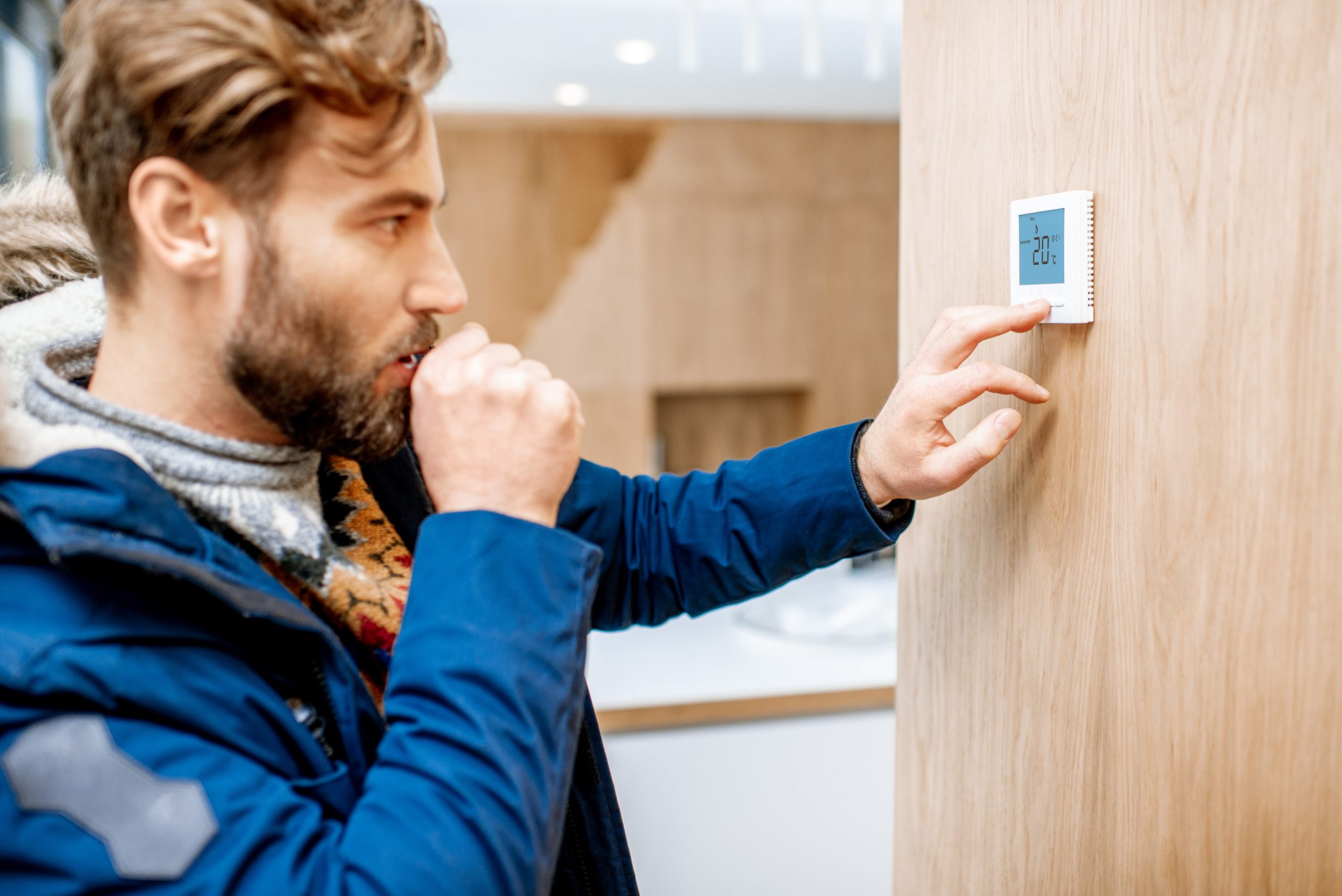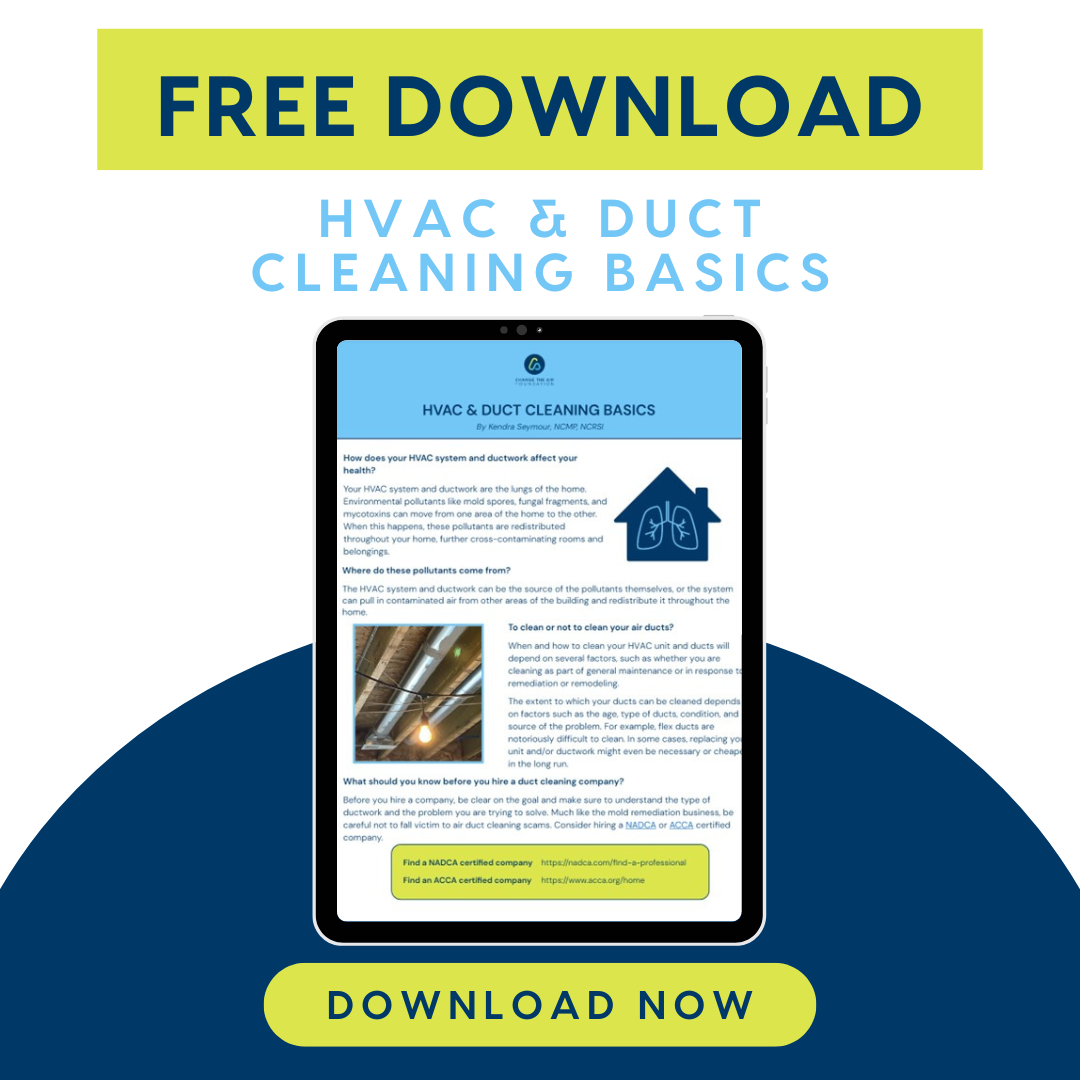Steps for Inspecting & Remediating Your Home For Mold & Water Damage
Clean the rest of the home and belongings (sometimes known as small particle cleaning), and consider the HVAC and ductwork (if HVAC and ductwork were not addressed as part of Step 2) to remove cross-contamination. Additional testing may be considered at this point.
Why clean the rest of the home and belongings along with heating and cooling systems like the HVAC and ductwork?
Unfortunately, it may not be enough to simply remediate the areas of physical microbial growth. It is often necessary to also clean up any cross-contamination caused by these areas of growth, especially if anyone in the home is experiencing any health symptoms. Your IEP can help you determine the extent of any cross-contamination and advise you based on your unique situation.
It can be helpful to think of mold growth like a factory. When people are working inside a factory, smoke may be produced. This smoke is a byproduct that cross-contaminates and pollutes the surrounding air.
The same idea is true for mold. As an active mold colony is growing, it releases byproducts into the environment. Instead of smoke, the byproducts can include mold spores, fungal fragments, mycotoxins, microbial volatile organic compounds (mVOCs), etc.
These invisible pollutants can travel throughout your home and settle on surfaces. The extent to which cross-contamination occurs is dependent on many factors. Even normal air currents in a home, heating and cooling systems (HVACs, mini splits, etc.), and day-to-day activities by people or pets can influence how far cross-contamination is spread. You can keep fighting to remove the “smoke” produced by these mold factories (a losing battle), or you can stop the air pollution for good by shutting down the mold factory.
Unfortunately, shutting down the mold factory doesn’t mean all that air pollution disappears. Once the mold byproducts are released, they remain in the indoor environment until removed.
Good remediation involves safely removing the mold growth and all the byproducts (spores, fungal fragments, mycotoxins, etc.) produced by that growth.
Think of it this way:
Step 1: Shut down the factory.
Step 2: Clean up byproducts made by the factory.
Sadly, most remediation only focuses on mold growth and ignores the cross-contamination. Even though spores, fungal fragments, and mycotoxins are not living, they still may pose a health risk to people and animals and should be safely removed.
Bottom line: Mold spores, fragments, mycotoxins, and other byproducts can remain in the environment long after the original source of mold growth is removed. This cross-contamination may continue to cause symptoms in people and pets until it’s properly removed.
Who can clean the rest of the home and what does that involve?
Cleaning the rest of the home from any cross-contamination is generally a tedious and time-consuming project. This process is sometimes known as small particle cleaning. The goal of this type of cleaning is to remove mold spores, fragments, mycotoxins and other particles before they can become resuspended into the air. Your IEP, along with your knowledgeable healthcare practitioner, can advise you on your unique situation, including the best people and process to address it. Below are some general considerations.
The decision on who performs this work often depends on time and cost considerations. While a remediation company may be contracted to clean the rest of the home, it is often extremely costly and not always an available option. In some cases, a cleaning company that is willing to follow specific instructions may be advisable. More often than not though, homeowners and renters frequently undertake this process themselves in order to save money and ensure it is performed correctly. (As a reminder, this section is dedicated to removing settled spores, fungal fragments, mycotoxins, etc. that are present as a result of cross-contamination. Areas of physical mold growth need to be discarded or properly remediated.)
Note: It may not be advisable for an individual who is sick or sensitive to mold to do the cleaning themselves. They may need to involve friends, family, or a third party such as a cleaning service. Propper PPE should also be considered.
Cleaning structural parts of your home from cross-contamination:
Cleaning floors, walls, ceilings, counters, cabinets, and other solid surfaces can seem like an overwhelming process, but the good news is with some elbow grease and common household items, you can reduce dust and any settled particles in your home. Please note that in order to protect your health, it may be advisable to wear proper Personal Protective Equipment (PPE) and improve the ventilation and filtration in the home.
In general, you will start by cleaning surfaces from the highest points (ceilings and ceiling fans) to the lowest points (walls to floor), beginning in the back of the room and working your way to the front. You can use a process known as a “HEPA Pizza'' which can be used to remove settled spores, fungal fragments, mycotoxins, and bacteria:
Remember to go slow during the cleaning process to ensure that you are not missing sections and are cleaning all components including light switches, window frames, molding, and baseboards. Be sure to change microfiber clothes frequently. It may be necessary to purchase extension poles designed for microfiber cloths to assist with cleaning ceilings, walls, and floors. To learn more about small particle cleaning your home after mold remediation, check out Part #10 of our Mold Remediation Mini Class series with Jessica McQuade where she breaks down each step of this cleaning process including the specific tools and techniques you can use.
For a more detailed explanation of small particle cleaning, download your free copy of "Small Particle Cleaning 101" provided by the International Society for Environmentally Acquired Illness (ISEAI) here. You can learn more about effective cleaning, including considerations for carpet, in Part 1 and Part 2 of our interview with John Banta.
Cleaning your possessions from cross-contamination:
The extent to which possessions can be cleaned is individualized and complicated. It is dependent on many factors including type of material, type of mold, level of contamination, removal method, and health and sensitivity of the people in the home. Note: It is recommended to discard porous and semi-porous items that have physical mold growth.
Begin by sorting your possessions based on porosity and value. The table below provides one convenient way to approach various possessions. It has been adapted with permission from We Inspect, a nationwide mold inspection company that prioritizes the connection between mold and health, specializing in serving hypersensitive individuals by locating hidden mold sources contributing to their symptoms.

Once you have categorized items, it’s time to clean them. It is best to clean possessions outside of the home if possible to reduce any particles that are kicked up into the environment during the cleaning process. If it’s not possible, strategize in advance about how to clean the items first, then protect them while cleaning the surrounding structure.
Cleaning steps will vary by material but can involve a combination of HEPA vacuuming, damp wiping, and in some cases, the use of compressed air. Clothing may be washable depending on the material and condition.
To learn more about the specific cleaning steps for various household possessions, We Inspect has generously shared their comprehensive guide which outlines how to categorize and how to attempt to clean items in each category. Their "Content Cleaning Guide" can be downloaded for free here. You can also download your free copy of "Keep or Toss 101: Dealing with Belongings" from the International Society for Environmentally Acquired Illness (ISEAI) here.
Lastly, dealing with possessions can be overwhelming. Some people find it helpful to put contents in a climate-controlled storage facility to be reevaluated at a later time. When someone is sick or sensitive to mold, exposure to possessions from their moldy home may trigger symptoms. A sensitized individual may react to seemingly small amounts of cross-contamination. With enough cleaning, time, and healing, it can be possible to reintroduce items to a sensitized person and have them not react.
IMPORTANT
There are no established thresholds determining whether “X” amount of a certain mold will cause negative health effects, while “Y” amount will not. What is “clean” enough for one person may not be “clean” enough for another. Success with dealing with your possessions will vary greatly due to the unique nature of the situation and the complexity of mold exposure. Trust your gut and work with a knowledgeable healthcare practitioner and IEP.
Who can clean heating and cooling systems like HVACs and ductwork, and what does that involve?
Heating and cooling systems, along with any ductwork that may be involved, can be a source of mold growth and/or contribute to cross-contamination. You can even think of these systems like they are the lungs of your home.
Mold spores, fungal fragments, mycotoxins, and any other particles in the air can move through heating and cooling systems. Work with your IEP to determine if, how, and when to clean your system. The extent to which your system and ductwork can be cleaned depends on many factors. For example, the ability to effectively clean your ductwork is dependent on age, type (flex, rigid, insulated, etc.), level of contamination, and condition of your ductwork. In some cases, cleaning ductwork may not be advisable or replacement may be a better choice.

It is important to clean your entire system, not just your ductwork. This includes drain pan, coils, grills, registers, air plenum, heat exchanger, air filter, blower motor, and assembly. According to the National Air Duct Cleaning Association (NADCA):
“Air duct cleaning is a misnomer. In actuality, the entire HVAC system should be cleaned. Failure to clean all components of the system can result in recontamination of the entire system, thus minimizing the benefits of cleaning. Just as you wouldn’t clean only half of your living room floor, you also would not want to clean only part of your HVAC system.”
Generally speaking, HVAC cleaning involves two key elements: breaking contaminants loose and collecting contaminants. To do this, the ductwork is cleaned by placing the entire system under negative pressure. This includes covering all supply and return registers. Then employing various agitation strategies and devices (hand brushing, contact vacuuming, air whips, compressed air nozzles, and “skipper balls”) that are used to break contamination loose.
Much like the remediation business, the air duct cleaning industry is filled with companies practicing ineffective and even unsafe practices. If air duct cleaning is done improperly, it can actually cause indoor air problems! You can download our free resource, “HVAC & Duct Cleaning Basics” to learn more about what the complete process should look like.
We recommend hiring a NADCA or ACCA certified company to clean your system.
We recommend hiring a NADCA or ACCA certified company to clean your system.
NADCA:
ACCA:
IMPORTANT
Use caution when hiring companies that want to spray, fog, disinfect, or sanitize your ductwork. The added chemical exposure, even with all-natural products, may pose a health hazard for some individuals. In some cases, it may even be illegal! NADCA’s Position Paper on Chemical Product Applications in HVAC Systems states:
“The EPA has not registered any products for sanitizing or disinfecting ductwork. Further, no fungicides are registered for use in ductwork. As noted earlier in this document, IT IS A VIOLATION OF FEDERAL LAW TO USE A PRODUCT IN A MANNER INCONSISTENT WITH ITS LABELING. For antimicrobials, this law is the Federal Insecticide, Fungicide, and Rodenticide Act (FIFRA). Therefore, any claims of sanitizing or disinfecting ductwork would require the use of a product in a manner inconsistent with its labeling, which is a violation of FIFRA. Violations of FIFRA can result in fines and criminal penalties from the EPA.”

